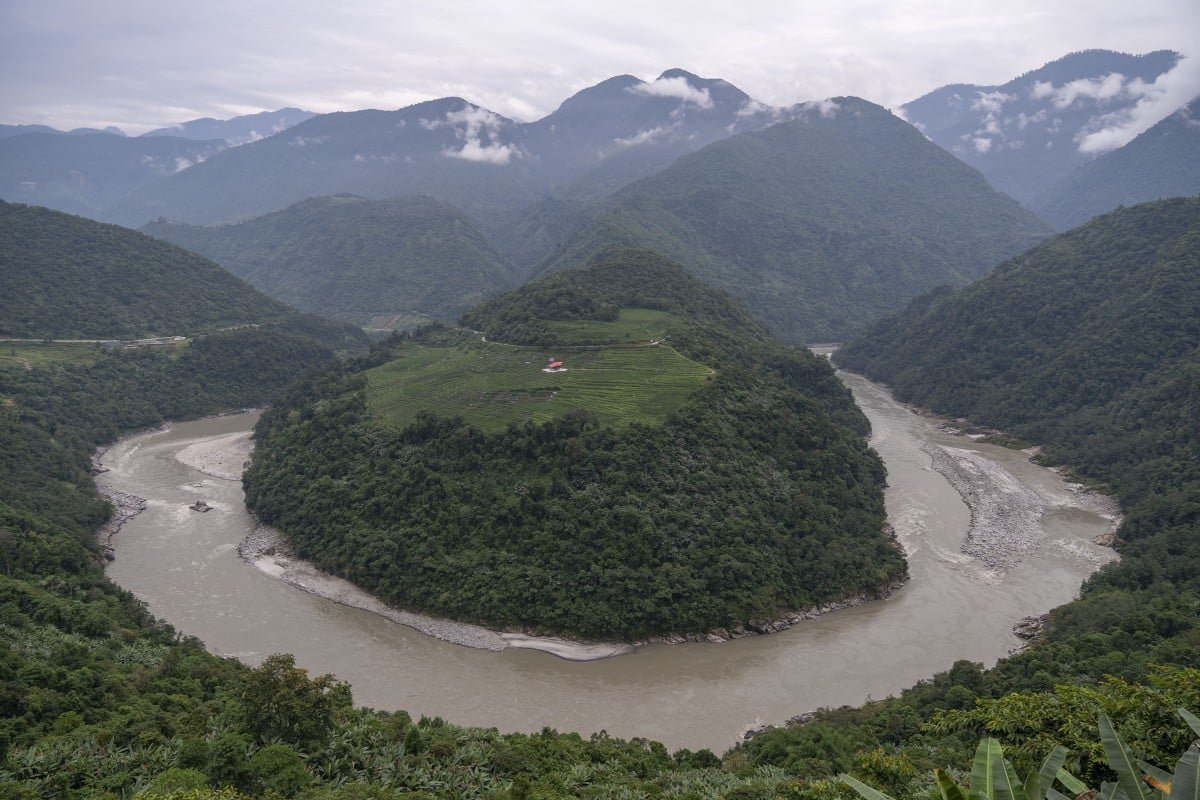On the rugged highlands of Tibet, where the Yarlung Tsangpo River carves a majestic path before cascading into the plains of India and Bangladesh, China has unveiled plans for the Tibet hydropower project, a development of unprecedented scale. This proposed Tibet hydropower project—hailed as a feat of engineering brilliance by some and a looming environmental disaster by others—promises to reshape not only the physical landscape but also the geopolitical dynamics of South Asia.
The announcement of the project has sent ripples across borders, drawing admiration for its ambition and sharp criticism for its potential consequences. To understand its significance, we must delve into the intertwined narratives of regional power politics, environmental sustainability, and socio-economic development.
Geographical and Political Context
Tibet, often referred to as the “Roof of the World,” is a vast plateau region in the heart of Asia and the site of the ambitious Tibet hydropower project. Known for its towering peaks and sacred rivers, it is home to the Yarlung Tsangpo River, one of the highest and most powerful rivers in the world. While Tibet is geographically and culturally distinct, it is an autonomous region under the sovereignty of China. This political arrangement has been a source of international and local contention, with many Tibetan groups advocating for greater autonomy or independence, adding a layer of complexity to any major infrastructure project in the region.
The Yarlung Tsangpo flows eastward through Tibet before turning sharply south to become the Brahmaputra River as it enters India and later Bangladesh. Its journey through such diverse terrains and nations makes it a lifeline for millions of people, emphasizing the significance of any alterations to its flow or ecosystem.
Geopolitical Underpinnings
For China, the Tibet hydropower project represents more than just an infrastructure endeavor. It symbolizes a strategic move in the delicate game of geopolitics. Positioned in the Tibet Autonomous Region, the dam is envisioned to generate substantial renewable energy, bolstering China’s domestic energy supply and advancing its climate goals. However, the project’s location on a transboundary river—known downstream as the Brahmaputra—places it at the heart of regional tensions.
India, which relies heavily on the Brahmaputra for agriculture, drinking water, and hydropower, views the project with unease. Concerns center around potential disruptions to water flow, especially during dry seasons, and the risk of China leveraging water as a geopolitical tool. While China has assured downstream nations that the project will not harm their interests, historical mistrust and limited transparency in Sino-Indian relations exacerbate fears.
Beyond India, Bangladesh—situated at the river’s delta—could face amplified challenges. Reduced water flow or sedimentation could disrupt agriculture, fisheries, and the delicate balance of ecosystems in the Sundarbans mangrove forest. The dam’s potential to trigger diplomatic friction highlights the urgency of establishing robust frameworks for water-sharing and regional cooperation.
Environmental Calculus
In a region already grappling with the impacts of climate change, the environmental implications of this mega-dam are profound. The Yarlung Tsangpo traverses a fragile ecosystem, home to unique biodiversity and communities that have coexisted with the river for centuries. The construction of a massive hydropower dam raises alarms about habitat destruction, disruption of aquatic life, and the displacement of local populations.
Critics point to the risks posed by seismic activity in the Himalayan region, one of the most earthquake-prone zones on the planet. The potential for catastrophic dam failure—exacerbated by unpredictable glacial melt and extreme weather events linked to climate change—adds to the environmental and safety concerns.
Moreover, the alteration of natural river flow could have cascading effects on downstream ecosystems. Sedimentation patterns essential for maintaining fertile deltas may be disrupted, affecting agriculture and fisheries. The dam also poses a threat to aquatic species such as the Gangetic river dolphin, already classified as endangered.
Proponents, however, argue that the project aligns with global calls for renewable energy. By harnessing the river’s immense potential, China aims to reduce its dependence on fossil fuels, contributing to global efforts to combat climate change. Yet, questions linger about whether the environmental costs outweigh the benefits, especially in a region so ecologically and geologically sensitive.
Narratives and Perspectives
China’s official narrative positions the dam as a cornerstone of its green energy strategy and a testament to its engineering prowess. State media highlight the project’s capacity to generate clean energy equivalent to several nuclear plants, emphasizing its role in advancing sustainable development.
In stark contrast, environmental groups and international experts warn of the irreversible damage such projects can inflict. They call for comprehensive environmental impact assessments, greater transparency, and adherence to international norms governing transboundary rivers.
Voices from affected communities reveal a more human dimension. Tibetan residents express concerns about losing their homes and cultural heritage, while downstream farmers in India and Bangladesh fear for their livelihoods. These perspectives underscore the need for inclusive dialogue and equitable solutions.
Long-term Implications
The Tibet hydropower project is a harbinger of the challenges and opportunities that accompany large-scale infrastructure projects in the 21st century. Its completion could cement China’s dominance in hydropower, setting a precedent for similar projects on other transboundary rivers. However, it also risks entrenching regional rivalries and ecological vulnerabilities.
In an ideal scenario, the project could catalyze collaboration among South Asian nations, fostering agreements on water-sharing and joint environmental stewardship. Conversely, a lack of consensus could exacerbate conflicts, deepening divisions in an already volatile region.
As the world watches, the Yarlung Tsangpo Tibet hydropower project stands as a testament to human ambition and a reminder of our responsibility to balance progress with preservation. Its story is still unfolding, shaped by the choices of governments, communities, and individuals. Whether it becomes a beacon of sustainable development or a cautionary tale of overreach remains to be seen.
Read complete paper by USA Defense
Read More News Blogs
FAQ....
The Tibet Hydropower Project is a proposed massive dam on the Yarlung Tsangpo River in Tibet. This ambitious initiative by China aims to harness the river’s immense potential to generate renewable energy and strengthen its energy grid.
The Yarlung Tsangpo River originates in the Tibetan Plateau and flows eastward through Tibet. It then takes a dramatic turn southward into India, where it becomes the Brahmaputra River, and continues into Bangladesh before reaching the Bay of Bengal.
Tibet is not an independent country. It is an autonomous region under the sovereignty of China. However, Tibet’s political status remains contentious, with calls for greater autonomy or independence from some Tibetan groups and international advocates.
The project is significant for several reasons:
Energy Goals: It represents China’s commitment to renewable energy and reducing reliance on fossil fuels.
Geopolitical Impact: It could influence water resource management and power dynamics in South Asia.
Environmental Concerns: The project raises questions about its sustainability and impact on fragile ecosystems.
The project poses several environmental risks, including:
Habitat destruction and biodiversity loss.
Disruption of aquatic ecosystems, including threats to endangered species.
Risks associated with building in a seismically active region prone to earthquakes.
India and Bangladesh, which rely heavily on the Brahmaputra for agriculture, drinking water, and fisheries, fear potential disruptions in water flow and sedimentation. Changes to the river’s natural patterns could impact agriculture, ecosystems, and livelihoods in these nations.
China positions the Tibet Hydropower Project as a critical part of its green energy strategy. The government emphasizes its potential to generate clean energy and support sustainable development while downplaying concerns about its transboundary impact.
Critics, including environmental groups and neighboring countries, highlight issues such as:
Lack of transparency in project planning.
Potential violations of international norms on transboundary water management.
The risk of ecological degradation and displacement of local communities.
While the project could strain relations, especially with India and Bangladesh, the potential for conflict depends on how China engages with its neighbors and adheres to water-sharing agreements. Effective diplomacy and cooperation could mitigate tensions.
The project could establish China as a leader in renewable hydropower but also set a precedent for exploiting transboundary rivers. Its long-term success depends on balancing energy production with ecological preservation and fostering regional cooperation.


Thanks for the article. I have usually seen that a majority of people are needing to lose weight simply because they wish to appear slim plus attractive. However, they do not often realize that there are additional benefits for losing weight additionally. Doctors insist that overweight people come across a variety of illnesses that can be instantly attributed to their own excess weight. The good thing is that people who are overweight as well as suffering from numerous diseases can reduce the severity of their particular illnesses through losing weight. You possibly can see a progressive but marked improvement in health if even a minor amount of fat reduction is realized.